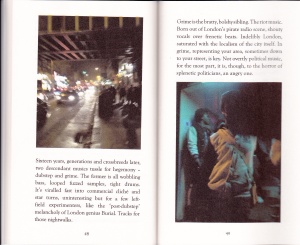Diagnostic Snapshots
Shove your hands in your pockets and set out. In London in winter it’s nearly pitch at half-past-four. By six, you’re in the night city, and in backstreets you can be alone for a long time.
A reader of Vertigo recently suggested that I might want to get my hands on a copy of China Miéville’s new book called London’s Overthrow, so I ordered a copy without giving it much thought. I’m glad I did. London’s Overthrow turns out to be a slim paperback from the newly formed Westbourne Press, but it shoehorns many things into a small package. Miéville’s essay is an anti-corporate and anti-government polemic, a brutal autopsy on Britain’s body politic, an activist’s commentary on the recent London riots and that city’s version of the Occupy movement, and a brick through the plate-glass window of modern urban planning. But it’s also a bit of a love letter to a dying version of London. Much like his fellow writer Iain Sinclair (who makes a guest appearance in London’s Overthrow, leading “a morose sewage pilgrimage” through the underbelly of some of London’s more rundown sections), Miéville rues the way in which “the neurotically planned and policed” London is rapidly erasing the sprawling, messy, organic city that took centuries of shifting human interactions to evolve.
Miéville’s essay originally appeared in March 2012 in the New York Times, where it was rather tamely titled “Oh, London, You Drama Queen” (a title presumably provided by the Times). Miéville’s writing was intended to be a counterpunch to the official, optimistic boosterism of pre-Olympic London, but the essay was unfortunately paired with a rather slick color photoessay by a professional photojournalist. The photographs, through no fault of the photographer, struck entirely the wrong note and served only to undermine the rawness of Miéville’s message.
Phase Two of London’s Overthrow was a website of the same name (it’s still up), where a revised version of the essay was smartly joined by photographs considerably more in keeping with Miéville’s noir pessimism. Miéville, who has a PhD in International Relations, is best known as a writer of fantasy fiction, and in London’s Overthrow, he writes with a liberating, non-academic, emotional, but nevertheless precise voice. He great at coining verbal mashups that deftly describe contemporary life. When protesters interrupt the Mayor of London by loudly proclaiming their love for him, Miéville pulls the term “crush-heckle” out of his hat. Any book that uses words and phrases include “soulectomy,” “sado-monetarism,” “pedestrian brandscape” (for a street of indistinguishable brand-name stores) has got to be a fun read – and London’s Overthrow doesn’t disappoint. My favorite is his definition of parkour as “a tough ruin ballet.” Here, language is a kind of dagger, lunging in one direction and pulling back, then lunging in another direction.
What so interests me about London’s Overthrow, though, is the photography. This book quietly echoes Robert Frank’s 1958 book of photographs The Americans in the way in which it uses a fresh, subjective aesthetic to serve as cultural criticism and, I would argue, a kind of ethical stance. In the absence of any photo credit, I can only assume that Miéville himself is the author of the photographs. But regardless of source, these photographs match his essay tone for tone. They are often badly lit, hastily composed, blurry images filled with bleeding colors and impenetrable shadows. They speak of our experience of things, not of things in and of themselves. In these photographs, light becomes gestural and the city can’t seem to sit still – even for a hundredth of a second. The way in which Miéville’s photographs describe the world – or, more accurately, fail to describe and catalog the world in full and utter detail – suggests that the highest authenticity is located within his gut reaction. This is documentary photography as polemic, an imagery born of new technologies that, ironically, make it possible to turn back the clock in terms of the history of image-making. As Miéville says near the start of London’s Overthrow:
There’s been a revolution in remembrance. Digital photography’s democratised the night-shoot. One touch at the end of a sleepy phone call on your way home, you can freeze the halo from streetlamps, the occluded moon, night buses, cocoons shaking through brick cuts, past all-night shops. Right there in your pocket, a little memory of now.
But wait, there’s more! In August, along came iteration three of London’s Overthrow, and it’s the best version of the lot. It’s a small softcover publication on paper that is just a step up from newsprint. It suggests the production values of a religious or political tract, which it is. The reproduction quality is wonderfully downmarket and suitably degraded from the luscious saturation and sheen of their bright, glowing cousins on the web version as viewed on a monitor. The photographs now have a slightly bleached-out look that feels completely right for Miéville’s “diagnostic snapshots.” As we see daily, the cellphone camera is the new weapon of choice. In the Westbourne Press version, the text and the photographs are totally in synch, offering an alternative vision more aligned with the “CGI end-times porn”that Miéville sees all around. And unlike the website, the book ends with a new photo-coda, a a final, new sequence of five pale, almost mono-colored, indistinct images that sends the reader off wordlessly on an indefinable journey. This is a book you can jam into your pocket as you head out into the night.
The book’s title, by the way, comes from an eponymous pen and ink drawing by Jonathan Martin, the brother of the British artist John Martin. “In 1829, obeying the Godly edict he could hear clearly, Jonathan set York Minster alight and watched it burn” and spent the rest of his life in Bedlam, London’s hospital for the insane.





